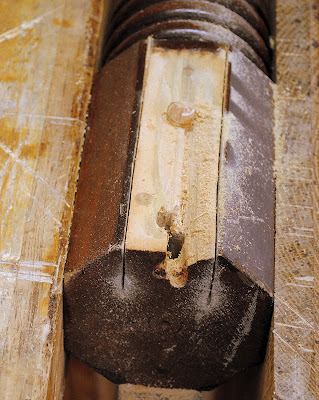Wednesday, February 19, 2014
Rescue Mission Part Three
I had replaced the cleats completely and repaired the leg that had the mounting bolt ripped from it, but the other leg was in a little bit more trouble. It had one of the feet torn from the body.


The foot side of things was easy to take care of. The broken dowels only needed to sawn of flush.

The leg side was a little more complicated. One dowel had been ripped out, chipping out a good amount of the surrounding wood. The best repair I could think of was to remove the broken wood and glue in wood to replace it and bring the surface out to the end of the leg again.

I started to define the sides of the section to be removed with my tenon saw.


Then I went after it with a chisel and a mallet until I had cleaned out a rectangular section.

Then I used some of the poplar scrap from the cleats and glued a couple strips in place, matching up face grain to face grain. A little glue to set the repair and I left it sit and cure overnight.

The next day, a couple swipes of a plane and the repair was flush with the leg and as good as new.

I drilled for the new dowels but clamping up the feet on the leg was going to be difficult with the curves of the feet. As much as I dislike jigs, I had to cut a couple simple ones to make the clamping go easier. I used some scrap pine and scribed the curves of the feet. A little bandsaw time and the clamping jigs were cut.

With one on each foot, I would have square surfaces to put my clamps on.

I clamped another couple pine scraps above the curved clamping jigs to keep them from sliding up under the clamps pressure.

A little more dry time on the glue and I could attach the cleats to the top of the legs.

Then reattach the legs to the bottom of the table.

Flip the table back over and test to make sure the drop leaf mechanisms work well and we can call the table done.

But I still had the chair to worry about.
Ratione et Passionis
Oldwolf
Subscribe to:
Post Comments (Atom)
No comments:
Post a Comment